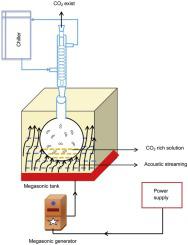Chemical Engineering and Processing: Process Intensification ( IF 3.8 ) Pub Date : 2020-03-20 , DOI: 10.1016/j.cep.2020.107913 R.K. Nilavuckkarasi , P. Muthumari , B. Ambedkar , M. Moniha

|
Global greenhouse gas emanations from fossil-fuel combusting for power-generation alone contribute 9.795 gigatonnes (Gt) in 2014. There is a tremendous focus on global carbon capture researchers to cut down these emissions significantly. Chemical absorption is widely used and the use of monoethanolamine (MEA) was generally preferred. However, MEA solutions were not without problems. For example, equipment deterioration due to O2 presence, high energy for solvent-regeneration, solvent degradation and formation of undesired harmful by-products inhibits the solvent's cyclic capacity. To address these issues megasonics-assisted (1 MHz - tank-type) solvent regeneration process had been investigated experimentally. The results revealed that low regeneration temperature (<45 °C), less condenser duty, the potential for sensible heat saving, no reboiler is required facilitates capital and maintenance saving, no significant colour change after regeneration and loss of absorption capacity after regeneration was 3.7 times lower than the conventional. In addition, similar regeneration energy (20.20 KJ/mol CO2) but with 3.5 times lower nominal power input than the conventional regeneration method. Furthermore, physicochemical characterization of the solvent before and after absorption and regeneration followed by 13C NMR spectra analysis was also discussed.
中文翻译:

基于溶剂的燃烧后CO 2捕集工艺(PCCC)中的富碳溶剂再生:通过超音速强化工艺
2014年,仅化石燃料燃烧产生的全球温室气体排放量就占了发电量的9.795千兆吨(Gt)。全球碳捕集研究人员非常重视大幅减少这些排放。化学吸收被广泛使用,并且通常优选使用单乙醇胺(MEA)。但是,MEA解决方案并非没有问题。例如,由于O 2而导致设备损坏存在,用于溶剂再生的高能量,溶剂降解以及不希望的有害副产物的形成抑制了溶剂的循环能力。为了解决这些问题,已经通过实验研究了超音速辅助(1 MHz-槽型)溶剂再生过程。结果表明,较低的再生温度(<45°C),较少的冷凝器负荷,潜在的节能潜力,无需再沸器可节省资金和维护费用,再生后无明显颜色变化,再生后吸收能力损失为3.7比传统的低十倍。此外,再生能量相似(20.20 KJ / mol CO 2),但标称功率输入比传统再生方法低3.5倍。此外,还讨论了溶剂在吸收和再生之前和之后的理化特性,然后进行13 C NMR光谱分析。











































 京公网安备 11010802027423号
京公网安备 11010802027423号